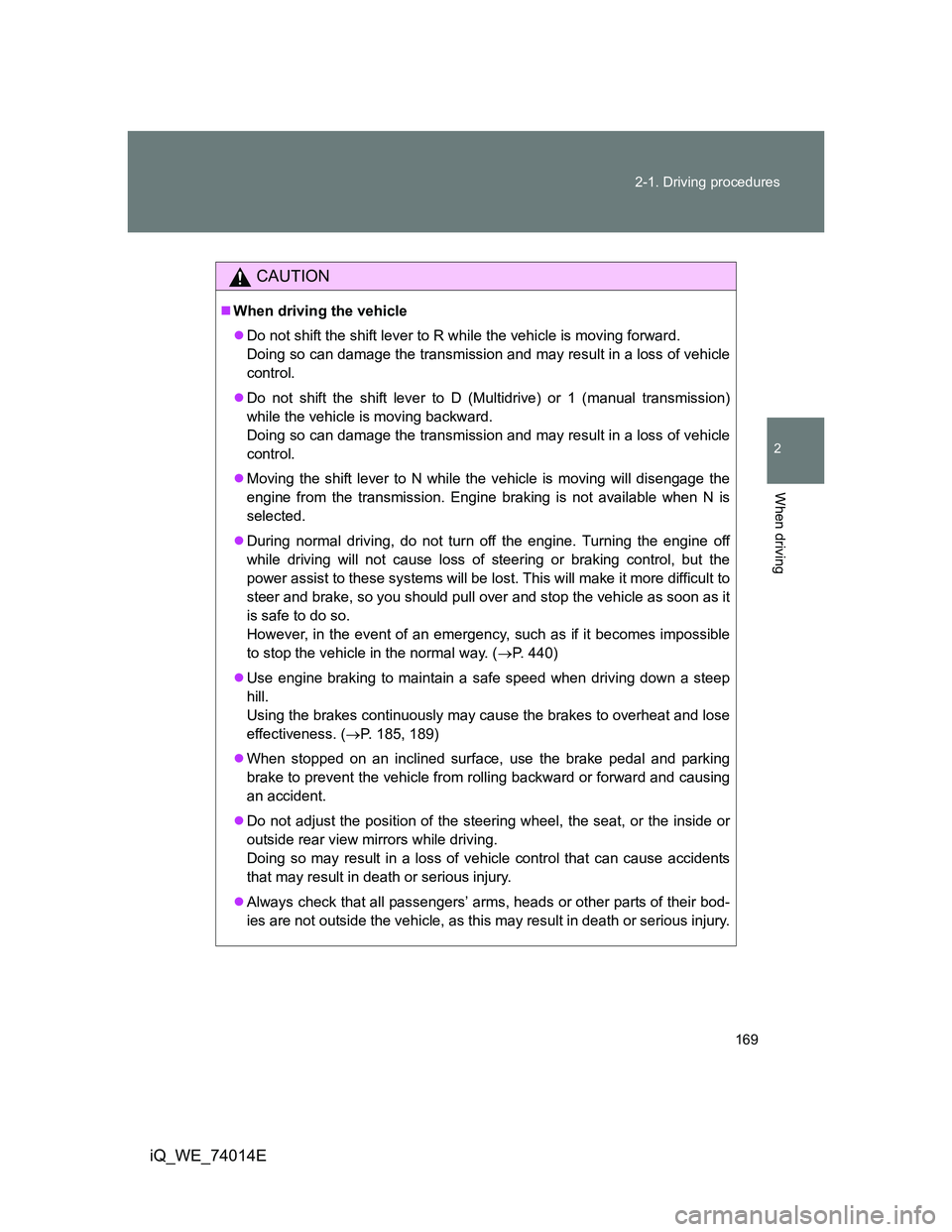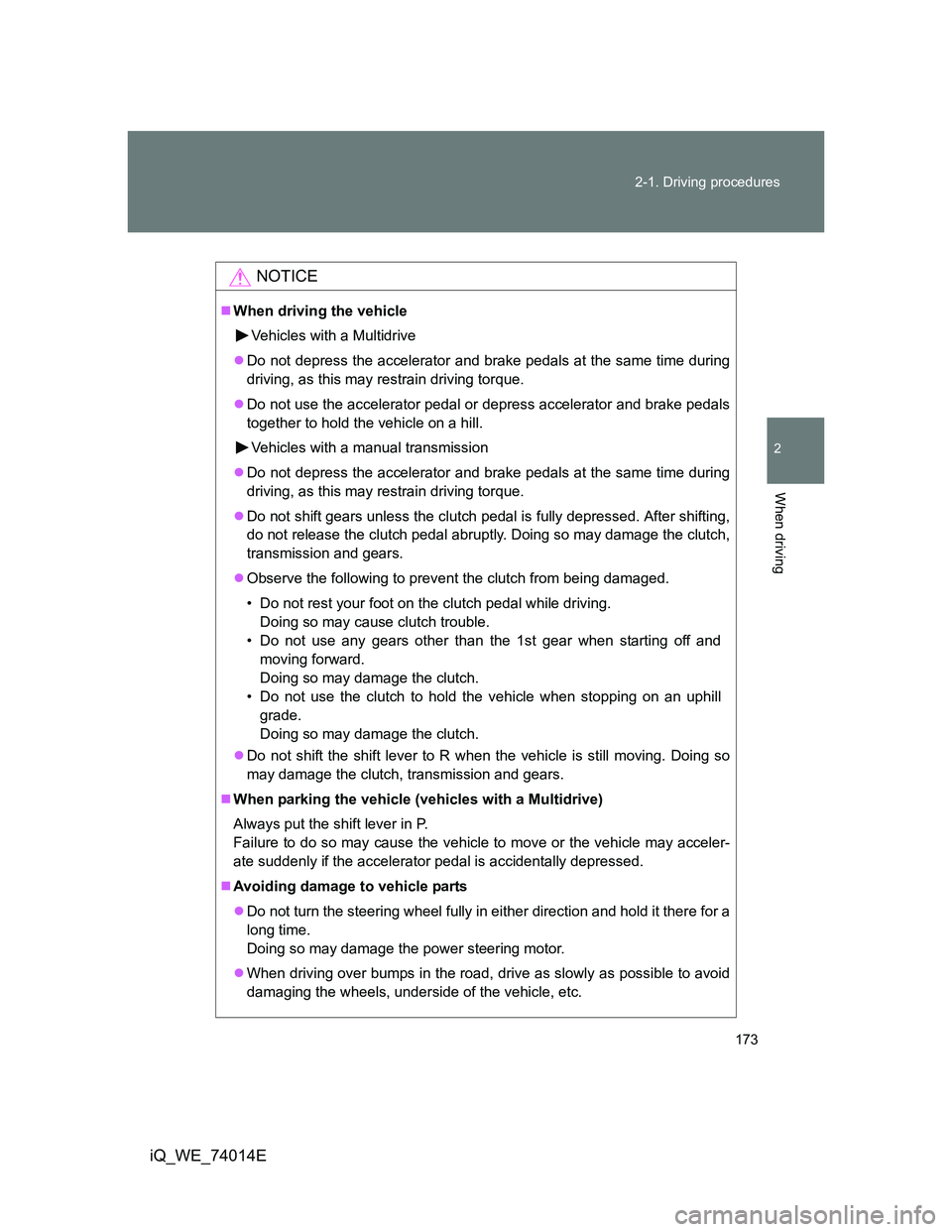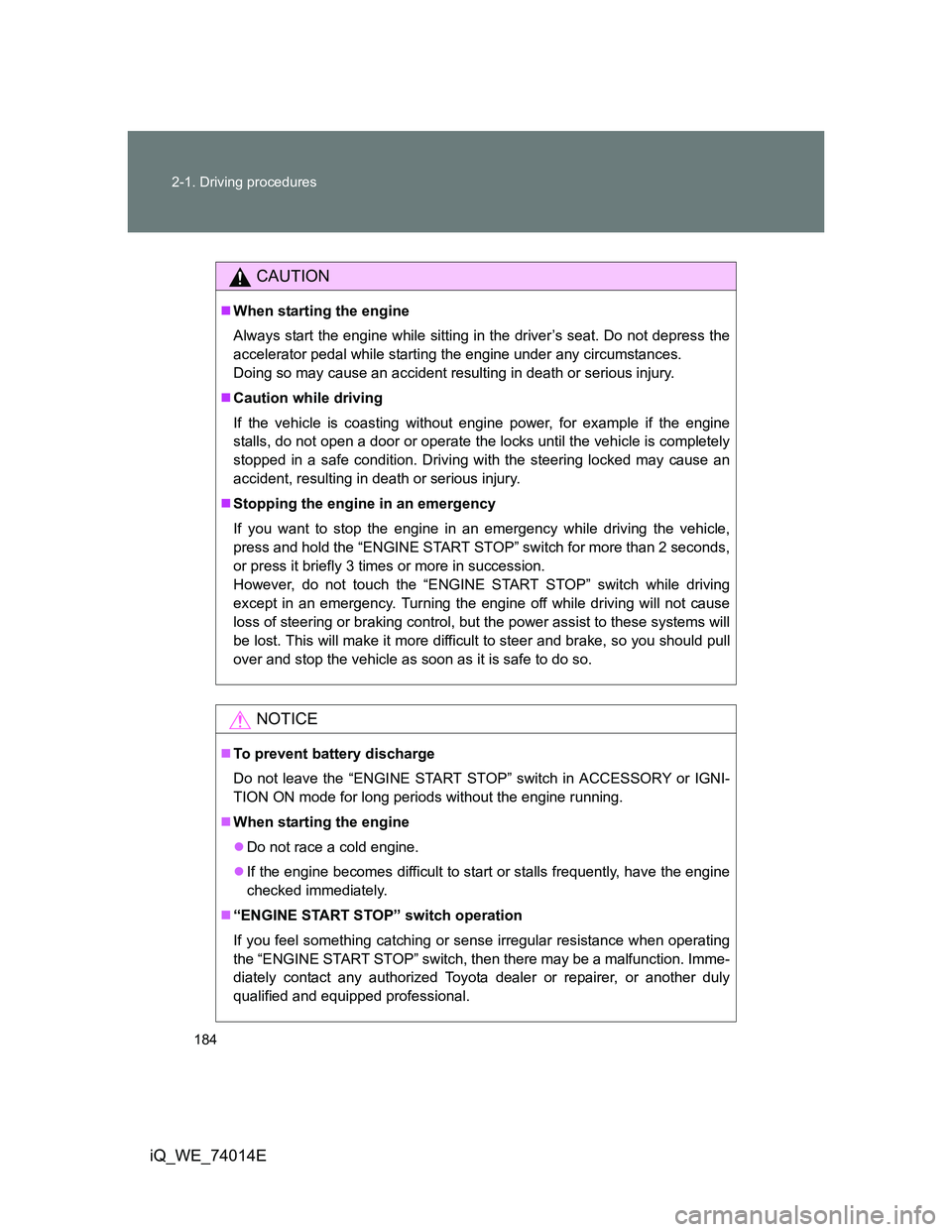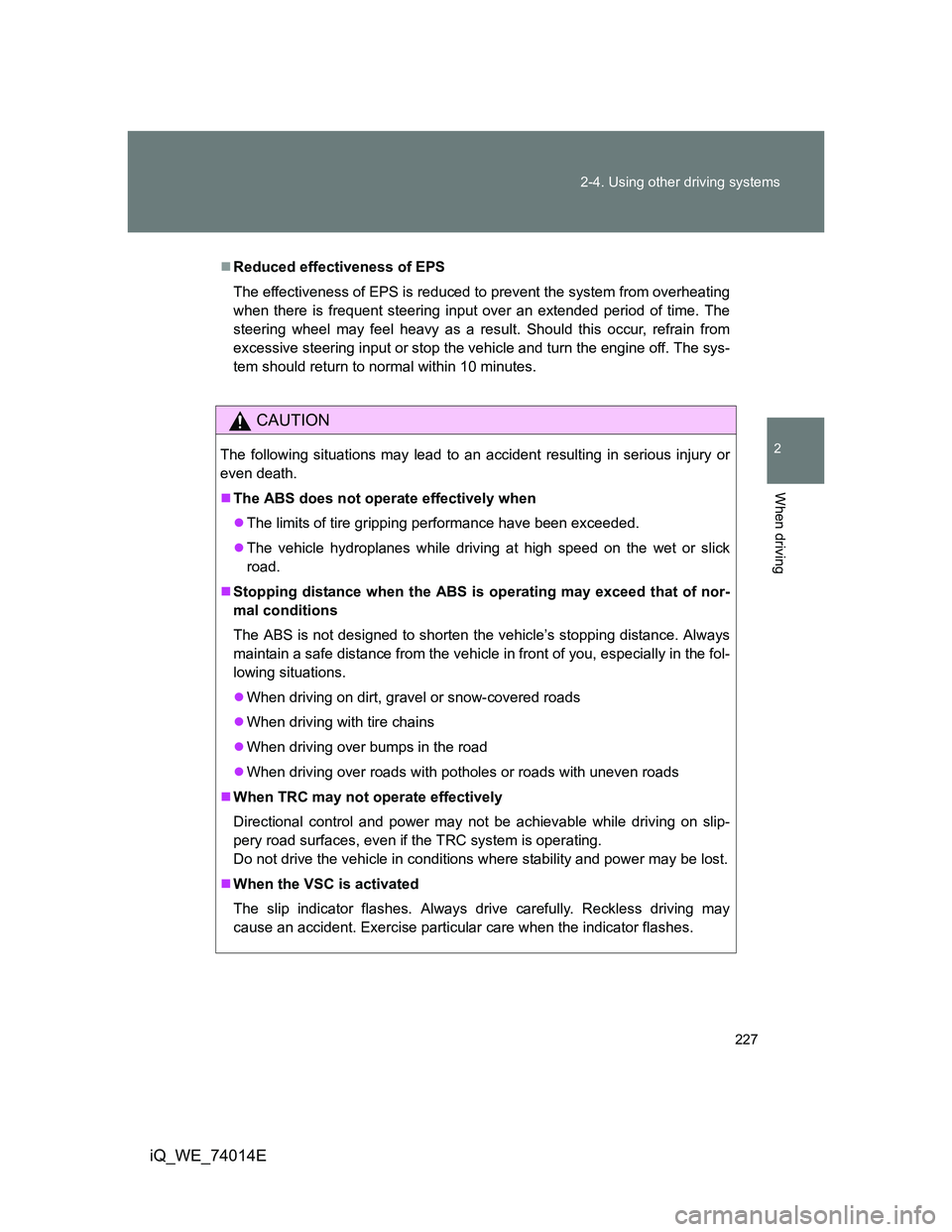2012 TOYOTA IQ power steering
[x] Cancel search: power steeringPage 2 of 476

TABLE OF CONTENTSIndex
2
iQ_WE_74014E
1-1. Key information
Keys ...................................... 36
1-2. Opening, closing and locking
the doors
Smart entry & start system ... 39
Wireless remote control ........ 62
Side doors............................. 72
Back door.............................. 75
1-3. Adjustable components
(seats, mirrors, steering
wheel)
Front seats ............................ 79
Rear seats ............................ 82
Seat belts .............................. 86
Steering wheel ...................... 91
Anti-glare inside rear
view mirror .......................... 92
Outside rear view mirrors...... 95
1-4. Opening and closing
the windows
Power windows ................... 100
1-5. Refueling
Opening the fuel tank cap ... 103
1-6. Theft deterrent system
Engine immobilizer
system .............................. 108
Double locking system ........ 117
Alarm .................................. 1191-7. Safety information
Correct driving posture ....... 122
SRS airbags ....................... 124
Child restraint systems ....... 137
Installing child restraints ..... 148
Airbag manual on-off
system.............................. 159
2-1. Driving procedures
Driving the vehicle .............. 164
Engine (ignition) switch
(vehicles without smart
entry & start system) ........ 176
Engine (ignition) switch
(vehicles with smart
entry & start system) ........ 179
Multidrive ............................ 185
Manual transmission .......... 189
Turn signal lever................. 193
Parking brake ..................... 194
Horn ................................... 196
2-2. Instrument cluster
Gauges and meters............ 197
Indicators and warning
lights................................. 199
Multi-information display .... 205
1Before driving
2When driving
Page 3 of 476

1
2
3
4
5
6
3
iQ_WE_74014E
2-3. Operating the lights and
wipers
Headlight switch.................. 211
Fog light switch ................... 216
Windshield wipers and
washer .............................. 218
Rear window wiper and
washer .............................. 222
2-4. Using other driving systems
Driving assist systems ........ 224
2-5. Driving information
Cargo and luggage ............. 229
Winter driving tips ............... 231
Trailer towing ...................... 235
.
3-1. Using the air conditioning
system and defogger
Manual air conditioning
system .............................. 238
Automatic air conditioning
system .............................. 244
Rear window defogger ........ 252
Rear window and outside
rear view mirror
defoggers.......................... 2543-2. Using the audio system
Audio system type .............. 257
Using the radio ................... 260
Using the CD player ........... 265
Playing back MP3 and
WMA discs ....................... 272
Optimal use of the audio
system.............................. 280
Using the AUX port ............ 282
Using the steering wheel
audio switches ................. 284
3-3. Using the interior lights
Interior lights list ................. 286
• Interior light ...................... 287
3-4. Using the storage features
List of storage features....... 288
• Cup holder ....................... 289
• Bottle holders ................... 289
• Auxiliary box..................... 290
3-5. Other interior features
Sun visors .......................... 293
Vanity mirrors ..................... 294
Power outlet ....................... 295
Seat heaters ....................... 296
Assist grips ......................... 298
Floor mat ............................ 299
Luggage compartment
features ............................ 301
3Interior features
Page 35 of 476

1Before driving
35
iQ_WE_74014E
1-1. Key information
Keys.................................... 36
1-2. Opening, closing and locking
the doors
Smart entry & start
system .............................. 39
Wireless remote control ...... 62
Side doors .......................... 72
Back door ........................... 75
1-3. Adjustable components
(seats, mirrors, steering
wheel)
Front seats.......................... 79
Rear seats .......................... 82
Seat belts............................ 86
Steering wheel .................... 91
Anti-glare inside rear
view mirror ........................ 92
Outside rear view mirrors ... 95
1-4. Opening and closing
the windows
Power windows................. 1001-5. Refueling
Opening the fuel tank
cap .................................. 103
1-6. Theft deterrent system
Engine immobilizer
system ............................ 108
Double locking
system ............................ 117
Alarm ................................ 119
1-7. Safety information
Correct driving posture ..... 122
SRS airbags...................... 124
Child restraint systems ..... 137
Installing child restraints ... 148
Airbag manual on-off
system ............................ 159
Page 169 of 476

169 2-1. Driving procedures
2
When driving
iQ_WE_74014E
CAUTION
When driving the vehicle
Do not shift the shift lever to R while the vehicle is moving forward.
Doing so can damage the transmission and may result in a loss of vehicle
control.
Do not shift the shift lever to D (Multidrive) or 1 (manual transmission)
while the vehicle is moving backward.
Doing so can damage the transmission and may result in a loss of vehicle
control.
Moving the shift lever to N while the vehicle is moving will disengage the
engine from the transmission. Engine braking is not available when N is
selected.
During normal driving, do not turn off the engine. Turning the engine off
while driving will not cause loss of steering or braking control, but the
power assist to these systems will be lost. This will make it more difficult to
steer and brake, so you should pull over and stop the vehicle as soon as it
is safe to do so.
However, in the event of an emergency, such as if it becomes impossible
to stop the vehicle in the normal way. (P. 440)
Use engine braking to maintain a safe speed when driving down a steep
hill.
Using the brakes continuously may cause the brakes to overheat and lose
effectiveness. (P. 185, 189)
When stopped on an inclined surface, use the brake pedal and parking
brake to prevent the vehicle from rolling backward or forward and causing
an accident.
Do not adjust the position of the steering wheel, the seat, or the inside or
outside rear view mirrors while driving.
Doing so may result in a loss of vehicle control that can cause accidents
that may result in death or serious injury.
Always check that all passengers’ arms, heads or other parts of their bod-
ies are not outside the vehicle, as this may result in death or serious injury.
Page 173 of 476

173 2-1. Driving procedures
2
When driving
iQ_WE_74014E
NOTICE
When driving the vehicle
Vehicles with a Multidrive
Do not depress the accelerator and brake pedals at the same time during
driving, as this may restrain driving torque.
Do not use the accelerator pedal or depress accelerator and brake pedals
together to hold the vehicle on a hill.
Vehicles with a manual transmission
Do not depress the accelerator and brake pedals at the same time during
driving, as this may restrain driving torque.
Do not shift gears unless the clutch pedal is fully depressed. After shifting,
do not release the clutch pedal abruptly. Doing so may damage the clutch,
transmission and gears.
Observe the following to prevent the clutch from being damaged.
• Do not rest your foot on the clutch pedal while driving.
Doing so may cause clutch trouble.
• Do not use any gears other than the 1st gear when starting off and
moving forward.
Doing so may damage the clutch.
• Do not use the clutch to hold the vehicle when stopping on an uphill
grade.
Doing so may damage the clutch.
Do not shift the shift lever to R when the vehicle is still moving. Doing so
may damage the clutch, transmission and gears.
When parking the vehicle (vehicles with a Multidrive)
Always put the shift lever in P.
Failure to do so may cause the vehicle to move or the vehicle may acceler-
ate suddenly if the accelerator pedal is accidentally depressed.
Avoiding damage to vehicle parts
Do not turn the steering wheel fully in either direction and hold it there for a
long time.
Doing so may damage the power steering motor.
When driving over bumps in the road, drive as slowly as possible to avoid
damaging the wheels, underside of the vehicle, etc.
Page 184 of 476

184 2-1. Driving procedures
iQ_WE_74014E
CAUTION
When starting the engine
Always start the engine while sitting in the driver’s seat. Do not depress the
accelerator pedal while starting the engine under any circumstances.
Doing so may cause an accident resulting in death or serious injury.
Caution while driving
If the vehicle is coasting without engine power, for example if the engine
stalls, do not open a door or operate the locks until the vehicle is completely
stopped in a safe condition. Driving with the steering locked may cause an
accident, resulting in death or serious injury.
Stopping the engine in an emergency
If you want to stop the engine in an emergency while driving the vehicle,
press and hold the “ENGINE START STOP” switch for more than 2 seconds,
or press it briefly 3 times or more in succession.
However, do not touch the “ENGINE START STOP” switch while driving
except in an emergency. Turning the engine off while driving will not cause
loss of steering or braking control, but the power assist to these systems will
be lost. This will make it more difficult to steer and brake, so you should pull
over and stop the vehicle as soon as it is safe to do so.
NOTICE
To prevent battery discharge
Do not leave the “ENGINE START STOP” switch in ACCESSORY or IGNI-
TION ON mode for long periods without the engine running.
When starting the engine
Do not race a cold engine.
If the engine becomes difficult to start or stalls frequently, have the engine
checked immediately.
“ENGINE START STOP” switch operation
If you feel something catching or sense irregular resistance when operating
the “ENGINE START STOP” switch, then there may be a malfunction. Imme-
diately contact any authorized Toyota dealer or repairer, or another duly
qualified and equipped professional.
Page 224 of 476

224
iQ_WE_74014E
2-4. Using other driving systems
Driving assist systems
To help enhance driving safety and performance, the following sys-
tems operate automatically in response to various driving situations.
Be aware, however, that these systems are supplementary and
should not be relied upon too heavily when operating the vehicle.
ABS (Anti-lock Brake System)
Helps to prevent wheel lock when the brakes are applied suddenly, or if
the brakes are applied while driving on a slippery road surface.
Brake Assist
Generates an increased level of braking force after the brake pedal is
depressed, when the system detects a panic stop situation.
VSC (Vehicle Stability Control)
Helps the driver to control skidding when swerving suddenly or turning
on slippery road surfaces.
VSC+ (Vehicle Stability Control+)
Provides cooperative control of the ABS, TRC, VSC and EPS.
Helps to maintain directional stability when swerving on slippery road
surfaces by controlling steering performance.
TRC (Traction Control)
Maintains drive power and prevents the front wheels from spinning
when starting the vehicle or accelerating on slippery roads.
EPS (Electric Power Steering)
Employs an electric motor to reduce the amount of effort needed to turn
the steering wheel.
Page 227 of 476

227 2-4. Using other driving systems
2
When driving
iQ_WE_74014E
Reduced effectiveness of EPS
The effectiveness of EPS is reduced to prevent the system from overheating
when there is frequent steering input over an extended period of time. The
steering wheel may feel heavy as a result. Should this occur, refrain from
excessive steering input or stop the vehicle and turn the engine off. The sys-
tem should return to normal within 10 minutes.
CAUTION
The following situations may lead to an accident resulting in serious injury or
even death.
The ABS does not operate effectively when
The limits of tire gripping performance have been exceeded.
The vehicle hydroplanes while driving at high speed on the wet or slick
road.
Stopping distance when the ABS is operating may exceed that of nor-
mal conditions
The ABS is not designed to shorten the vehicle’s stopping distance. Always
maintain a safe distance from the vehicle in front of you, especially in the fol-
lowing situations.
When driving on dirt, gravel or snow-covered roads
When driving with tire chains
When driving over bumps in the road
When driving over roads with potholes or roads with uneven roads
When TRC may not operate effectively
Directional control and power may not be achievable while driving on slip-
pery road surfaces, even if the TRC system is operating.
Do not drive the vehicle in conditions where stability and power may be lost.
When the VSC is activated
The slip indicator flashes. Always drive carefully. Reckless driving may
cause an accident. Exercise particular care when the indicator flashes.